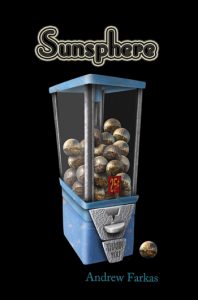Reviewed By: Lindsay Ball

In Andrew Farkas’ second short story collection Sunsphere, he weaves stories in alternate universes that all tie back to the city of Knoxville, Tennessee and its remaining landmark from the 1982 World’s Fair, the sunsphere. Farkas’ experimental, surrealist stories explore many different perspectives, from a grease addict to a narrator that does not really exist. Throughout the collection, Farkas investigates the mind and how different people think. His writing also explores the idea of societies, groups, and communities as well as the effect they have on individuals. In “The Physics of the Bottomless Pit,” he describes the life of a Stone, saying “the only long-term pals you have are other Stones who keep falling with you, but if they decide to become Toilers or even Flyers, then you leave them behind, making your own small transient community…” Farkas experiments with some of the bases of humanity, forcing characters into extenuating circumstances and questioning when people hit their breaking point.
Near the middle of the collection rests “Everything Under the Sunsphere,” a story about a man named Gene living in a version of Knoxville that suffers from extreme temperatures and a gang of arsonists. Both Gene and the city itself are attempting to manage an identity crisis. Gene says he is able to find relief through a woman named Stiria who “Cools me down wherever I am. She keeps me away from the heat, the burning, the scorching, the chaotic inferno, whether I’m with her or not.” Throughout the story, Gene struggles to understand himself and the city he lives in. As he tries to understand himself, Gene thinks “I like to think I was made in God’s own image. That God is just as awkward, and ridiculous, and sweaty as me, that He has so many names because He’s too timid to tell anyone they’re wrong…” The story also demonstrates the different ways people deal with extreme circumstances, such as Gene, the Phlogistonites, and others doing their best to survive in the chaotic world surrounding them.
Similarly to “Everything Under the Sunsphere,” “The Physics of the Bottomless Pit” explores the perspectives of characters attempting to create a life in a hectic environment. The piece is split up into multiple sections in order to show how different people in a society interact with and think about a bottomless pit that has opened up next to the sunsphere. One section includes a description of what to do in case of falling into a bottomless pit. Farkas writes that one should fall “like your parents told you to, expressly against your parents’ wishes, like a stone, like a brick, like a pillow…” Farkas also describes the sense of community that people attempt to create in the chaotic world, whether while falling in the pit or living in fear of the epidemic the pit has created. Through the story, Farkas demonstrates the various ways that people cope with a difficult situation, and his vivid language and imagery make readers feel as if they are there and can understand the current situation.
Another piece in the collection, “White Dwarf Blues,” allows Farkas to experiment even further with perspective. This self-proclaimed drug noir story is told by the narrator and main character, a drug addict whose “suicide of choice” is grease, specifically Captain D’s. Farkas uses this humorous voice to tell this story from a unique point of view. Throughout the story, Farkas plays with the idea of awareness through this protagonist who believes he is fully reliable and in control, whether he truly is or not is left up for the reader to determine. The main character states that “I can play both sides- the reliable narrator and the deluded junky. So, don’t worry. You can trust me from the beginning (which isn’t here yet) to the inevitable downer ending (oh, I can’t wait) in this my drug noir.” Farkas creates a feeling of unease throughout the story, despite its amusing tone. The contrast between the narrator’s cheery attitude and the darker elements of his story only adds to this feeling. The story is a journey through a stereotypical drug noir manipulated to fulfill Farkas’ greater purpose: to explore how a sense of identity affects a person’s life.
Through Sunsphere, Andrew Farkas develops ideas of self-identity and purpose through various characters. He explores how different circumstances and societies can impact a person’s views on both the world and his or herself. Each story in the collection is thought-provoking, forcing readers to evaluate their own existence as they journey through the various versions of Knoxville. Farkas’ writing weaves a world that engulfs readers for a few hours, until they breathlessly reach the conclusion with new knowledge about themselves, or at the very least how they might react to a ravaged version of Knoxville, Tennessee.
